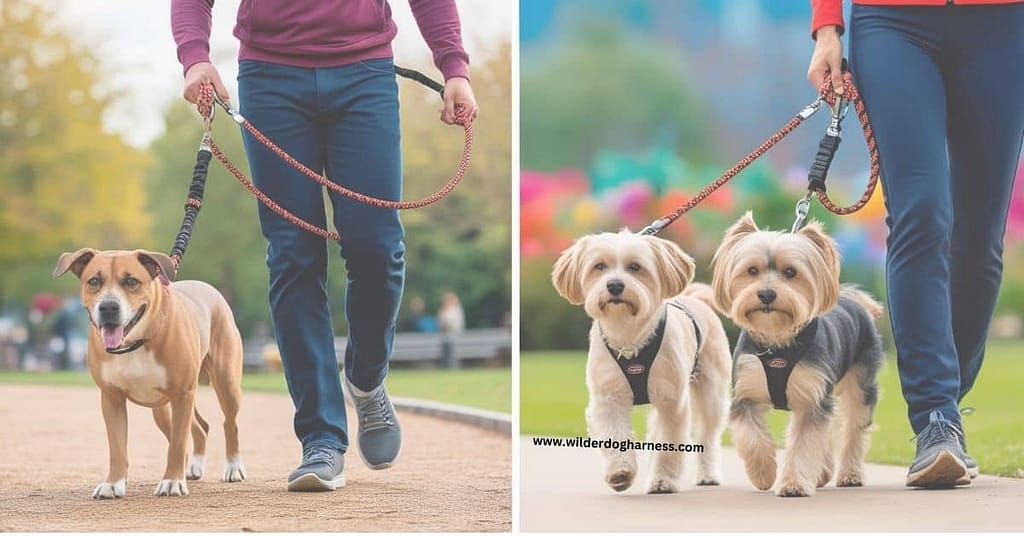Imagine this: Sarah, a 32- year- old busy mom living in Austin, Texas, has just adopted a large dog named Max, a jolly Labrador full of energy. On the very first walk that they shared, Max tugged hard, and Sarah found herself practically stumbling, trying to catch up. Frustrated and a little concerned, she searched for solutions, and voilà, she found the large- dog bungee leash. Suddenly, her walks with Max are smoother, less strained, and much more enjoyable. But why do dogs use bungee leashes? Let’s delve into it and find out why these inventive leashes have become a go-to for dog owners across the USA.

What’s the Deal With Bungee Leashes?
A bungee leash is one designed from elastic material. In simple words, this gives a little bit of stretch when the dog pulls to take off some of that shock. The rigid line will give jerks and tension; for that reason, with the bungee section, it will make the experience quite smooth for the dog and the owner too. But why does this matter? And what’s all the fuss about? Are bungee leashes any good? Let’s find out!
The Bungee Leash: Benefits You Can’t Ignore
Dogs use bungee leashes for a reason-or rather, dog owners choose bungee leashes for the wide array of benefits they offer. Here are some top reasons why bungee leashes are finding their niche in the market with an ever-increasing trend:
- Shock Absorption : The stretchy material reduces the impact when your dog pulls, thus making walks more comfortable.
- Joint Protection : It’s not all about comfort. The bungee leash will save your joints and the joints of your dog from sudden jerks.
- Better Control : Difficult to believe, but the give-and-take nature in a bungee leash would at times provide greater control over the movement of your dog.
- Reduced Injury Risk : In the case of active dogs, especially of larger breeds, a normal leash causes neck strain and can even injure them due to tugging hard. Bungee leashes reduce this risk.
Why do dogs use bungee leashes? Well, they don’t choose them, but owners sure do-because it is better for both dog health and human well-being.
Types of Bungee Leashes
Like with dogs, there is no one-size-fits-all with bungee leashes either. Coming in an array of different options depending on your pup’s size and temperament, there’s something available for every dog owner to choose from.
Bungee Leash for Large Dogs
Large canines such as Max need something sturdy, and this is where bungee leashes come in really handy. These heavy-duty leashes are designed to bear tugs that are strong and provide tension for better control. The best bungee dog leash intended for large breeds will feature durable clasps and reinforced handles that keep the safety intact but allow that little bit of elastic give.
Bungee Leash for Small Dogs
On the other hand, dogs of a smaller nature require less force absorption. For small dogs, a lighter type of bungee leash is needed, and the elasticity isn’t as pronounced. They’re thus not wasted on little pups who dart around unexpectedly, preventing those sudden jolts that may injure their tiny necks.
Best Bungee Dog Leash Options
Now, let’s take a brief overview of the most viable options in the market. Here is a table summarizing them:
| Leash Name | For | Main Features | Price Range |
|---|---|---|---|
| Mighty Paw Bungee Dog Leash | Large Dogs | Strong nylon, reflective stitching, padded handle | $ 25 – $35 |
| Ruffwear Roamer Bungee Leash | Active Dogs ( Any Size) | Adjustable length, quick- release buckle | $ 35 – $45 |
| Tuff Mutt Bungee Leash | Medium to Large Dogs | Heavy- duty carabiner, dual handles, tangle-free | $ 20 – $30 |
| Sparkly Pets Bungee Leash | Small Dogs | Lightweight, stretchable, with soft padded handle | $ 15 – $25 |
Why Bungee Leashes Are Great for Training
Training your dog sometimes can feel like a tug-of-war; sometimes it literally is. With a normal leash, whenever your dog pulls, it’s a strain on both. Over time, this will eventually make your dog realize that pulling seems to get results. With a bungee leash, on the other hand, there’s a soft stretch instead of an immediate resistance, which might snub pulling behavior.
Think of this as a compromise; the bungee gives your dog some freedom but not too much. This might be very helpful for dogs that are still in training to walk and not pull.
Are Bungee Leashes Suitable for All Dogs?
In one word: yes! But then again, let’s break it down by dog type:
- For Hyperactive Dogs : If your dog always has plenty of energy, dashing around and pulling on the leash, then a bungee leash will help ease that tension. They’ll get that sense of freedom without you feeling like you are always being dragged around.
- For Older Dogs : Bungee leashes can be good for older dogs with joint problems or arthritis since they reduce the number of sudden jerks that make walking painful.
- For Puppies : Puppies can be easier to train with a bungee leash, which disrupts the pulling instinct and gives them a wee bit of ease with leash training.
Like with everything else that exists on this earth, perfection doesn’t exist. Here are the things you need to consider when deciding if the bungee leash is right for your dog:
- Not for Heavy Pullers : Although a bungee leash does absorb some of the tension, it is no substitute for proper training. The heavy pullers will have to work out their leash manners.
- Elastic Wear : The elastic wear in bungee leashes may eventually wear out with time, and it is usually important to check for signs of fraying or weakening, especially if you have a strong dog.
Real-World Systems : When a Bungee Leash Saves the Day
Picture yourself strolling through a busy park with kids, dogs, and joggers galore. Your dog suddenly spots a squirrel, they do- and pulls hard on the leash. Instead of a normal leash whipping you into whiplash just to keep up, the sudden jolt of that tug is absorbed with a bungee leash. It’s totally manageable instead of being yanked off your feet. This could be a big deal for someone whose active dog spends much time in crowded situations.
Let’s say, in another instance, you are running along with your dog. If your dog pulls, it can quickly disturb your running rhythm and pace. In such a case, if you are on a bungee leash, the leash accommodates your dog’s movement, sans yanking you out of your stride.
Pros and Cons of Bungee Leashes
Let us take a look at the upsides and downsides of using a bungee leash:

Pros:
- Reduces shock and strain on both dog and owner
- Great for running and walking in highly trafficked areas.
- can be quite helpful for leash training and even in behavior management, as well.
- Helps avoid injuries that can be caused by sudden tugging.
- Perfect for all sizes of dogs, from tiny puppies to bigger puppy breeds.
Cons:
- The elastic does wear out over time.
- Not a substitute for leash training for extreme pullers.
- Some models can be more expensive than regular leashes.
Conclusion: Should You Get a Bungee Leash?
For anyone looking for a leash to make walking more pleasurable, both the human and the addition of a bungee leash may be just what is needed. The advantages that come along with a bungee leash are numerous: shock absorption, joint protection, and better control of your pet, just to name a few. To a dog owner like Sarah, it may mean the difference between dreading walks and looking forward to them.
Whether you have a large dog like Max or a smaller, energetic pup, there’s an option in bungee leashes out there to suit your needs. It is not just about easing the load from you, but it’s about giving your dog the safest and comfortable experience when out on a walk.
Now, if you are wondering why dogs use bungee leashes, here’s the simplest answer: because it makes life better for them and you!
See Also : Best Dog Leash with Two Handles: Your Mate for Adventures
FAQs: Why do dogs use bungee leashes?
Are all dogs safe on bungee leashes?
Yes, for the most part, bungee leashes are safe for most dogs, but one will have to select the appropriate size for your dog in terms of his size and strength. For heavy pullers or especially strong breeds, apply a high-quality, durable bungee leash for total safety. That means being on regular wear and tear inspection to avoid accidents.
Can bungee leashes help with leash training?
Yes, bungee leashes can be somewhat helpful in leash training because, when your dog pulls hard, the immediate pull-back is softened, thus less rewarding for them to continue tugging. Proper training techniques should be used concurrently to teach good leash manners.
How will I know whether a bungee leash is suitable for my dog?
A bungee leash may work out for you if your dog likes to pull while walking-or if you feel a constant strain on your arms and shoulders. They work fantastically on active dogs and for owners who jog with their dogs, as the elastic makes for a much smoother walk or jog.
Do bungee leashes work on small dogs?
Yes, there are bungee leashes that are specifically made for small dogs. The elastic used in these is lighter and more flexible, taking into account the much smaller size and less forceful pulls that small breeds can exert on the leash. Using a bungee leash on small dogs will prevent a potential injury while allowing give and mobility.
How long does a bungee leash last?
The quality of the materials and regularity of use will determine the bungee leash’s lifespan. A good-quality bungee leash made of durable material may well last for several years, but again, regular inspection of the elastic against wear or fraying is necessary, especially for strong pullers.



